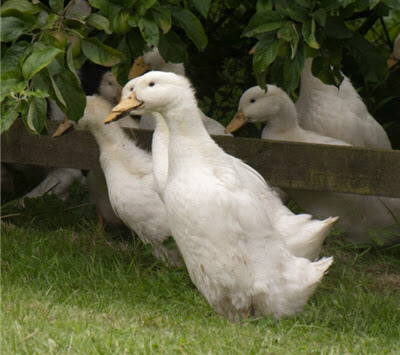German Pekin

Scientific Name
Anas platyrhynchos domesticus
Alternative Names
Deutsche Pekingente, White Pekin, European Pekin
Measurements:
| Feature | Male | Female |
|---|---|---|
| Length | About 60–70 cm (24–28 in) | About 55–65 cm (22–26 in) |
| Weight | 3.5–4.1 kg (7.7–9 lb) | 3–3.6 kg (6.6–7.9 lb) |
| Wingspan | Approximately 95–105 cm (37–41 in) | Approximately 90–100 cm (35–39 in) |
Status
As of 2025, the German Pekin is listed as “at risk/endangered” in Germany according to the FAO’s DAD-IS database. The Gesellschaft zur Erhaltung alter und gefährdeter Haustierrassen (GEH) classifies it as “seriously endangered.” While the breed remains vulnerable in continental Europe, it is more stable in the United Kingdom, where it is considered “not at risk.” Conservation programs are ongoing through rare breed associations and heritage waterfowl breeders.
Average Life Span
8–12 years
Breed History
The German Pekin traces its roots to Chinese ducks domesticated before 1000 AD. The breed’s European journey began in 1872, when Walter Steward imported birds of the Chinese shi-chin-ya-tze (“ten-pound duck”) type to the United Kingdom. From there, some were brought to Germany, possibly via France.
In Germany, breeders crossed the imported Chinese ducks with upright white ducks from Japan, resulting in a bird with a steep body angle and rich plumage. This sharply upright stance distinguishes the German strain from the American Pekin, which developed from similar imports but was crossed with Aylesbury ducks, resulting in a more horizontal posture.
By the early 20th century, the German Pekin had become a recognizable breed throughout Europe. However, following World War II, it lost prominence in agriculture and became primarily a show bird. The modern British Pekin also largely descends from German imports made around 1970.
Identification
The German Pekin is a large, upright duck with a creamy white plumage that often shows a yellowish tinge. It has a short, orange bill, deep body, and strong legs set far back, giving it a vertical, almost comical stance. The eyes are blue-gray, and the neck is thick and moderately arched. The feathers are dense, creating a plush, soft appearance.
Purpose
Originally bred as a table bird, prized for its tender, flavorful meat and rapid growth rate. Today, the German Pekin is mainly kept as an ornamental and exhibition breed, admired for its distinctive posture and creamy plumage.
Breed Eggs
German Pekin ducks are modest layers, producing about 80 eggs per year.
- Egg color: White
- Average weight: ~80 g (2.8 oz)
- Laying season: Spring through early summer
While not prolific, the breed’s eggs are large and nutritious.
Temperament & Behavior
German Pekins are calm, friendly, and easy to handle. Despite their heavy bodies, they are energetic foragers and adapt well to enclosed runs or free-range conditions. Their flight ability is minimal due to their weight. They have a gentle quack, though females can be more vocal during breeding or feeding times.
Genetic Profile
Descended from Chinese domestic ducks, the German Pekin’s distinctive upright posture comes from crossbreeding with Japanese upright white ducks in the 19th century.
- Color genetics: Dominant white with creamy overtones caused by dilution factors.
- Body shape genetics: Selective breeding for a steep angle (vertical body carriage) maintained through show standards.
- The breed is genetically distinct from the American Pekin, despite similar ancestry.
